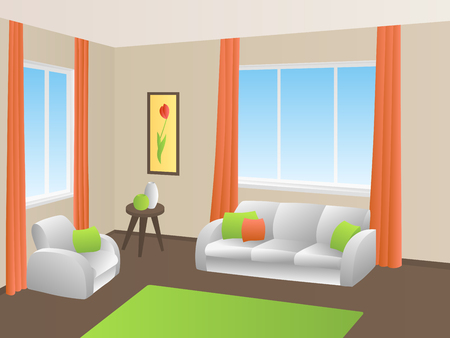Understanding Feng Shui Principles for American Homes
Feng Shui is an ancient Chinese practice that focuses on creating harmony and balance in your living space. In the context of American homes, especially when arranging a living room, Feng Shui’s core ideas can be adapted to fit different architectural styles, sizes, and layouts commonly found across the United States.
What Is Feng Shui?
At its heart, Feng Shui is about the flow of energy—known as “chi”—throughout your home. The goal is to arrange furniture, décor, and even colors in a way that promotes positive vibes, comfort, and well-being. While traditional Feng Shui was developed for Chinese homes centuries ago, its principles can work just as well in modern American living rooms, whether you have an open-concept space or a cozy apartment.
Core Feng Shui Concepts Adapted for American Living Rooms
| Feng Shui Principle | How It Applies to American Homes |
|---|---|
| Command Position | Place the main sofa so you can see the entryway but are not directly in line with the door. This creates a sense of security and control. |
| Clear Pathways | Avoid blocking walkways with furniture. Make sure there’s enough space to move around easily, which keeps energy flowing freely. |
| Balance Elements | Incorporate a mix of materials (wood, metal, fabric), colors, and shapes to create visual harmony. For example, balance soft sofas with sleek tables or add plants for natural energy. |
| Declutter Regularly | Keep your living room tidy and free of unnecessary items. Clutter can block positive energy and create stress. |
| Natural Light and Air Flow | Open windows when possible or use light curtains to maximize natural sunlight. Good air circulation is key for healthy chi. |
Why Adapt Feng Shui for American Living Rooms?
American homes come in all shapes and sizes—from suburban houses with large family rooms to city apartments with limited space. Adapting Feng Shui means using its timeless ideas to make any living room feel more comfortable and inviting without needing major renovations or expensive décor. Whether your style is modern farmhouse or mid-century chic, these principles help you create a living space that feels good to be in every day.
2. Choosing the Ideal Furniture Placement
Arranging your living room furniture for good Feng Shui in an American home is all about creating a comfortable, inviting space that encourages positive energy flow—or “chi”—while still fitting your family’s lifestyle and the way you use your space. Whether you have an open-concept layout or a more traditional living room, these tips will help you find the best spots for couches, chairs, and tables.
Sofa Placement: The Command Position
In Feng Shui, the sofa should be placed in what’s called the “command position.” This means your main couch faces the entrance to the room but isn’t directly in line with the door. Ideally, place it against a solid wall for support. If your living room is open-concept and doesn’t have a wall available, use a console table or low bookshelf behind your sofa to create a sense of stability.
Common Sofa Arrangements
| Room Style | Sofa Placement Tips |
|---|---|
| Open-Concept | Float the sofa with its back to a subtle divider (like a rug or table), facing toward the main gathering area, not the kitchen or hallway. |
| Traditional Layout | Place against a solid wall with a clear view of the entryway and enough space on each side for balance. |
Chairs: Conversation and Comfort
Arrange chairs so they encourage conversation without blocking pathways. Angle them slightly toward the sofa or around a coffee table to make everyone feel included. Avoid placing chairs with their backs to doors or windows if possible.
Tips for Chair Placement
- If you have two chairs, place them at right angles to the sofa for easy chatting.
- For larger spaces, create smaller seating zones using pairs of chairs near windows or bookcases.
- Always allow enough space between chairs and walls for easy movement—at least 18 inches if possible.
Coffee Tables and Side Tables: Balance and Flow
Coffee tables should be accessible but not block movement. Round or oval shapes are considered most harmonious in Feng Shui, as they allow energy to flow smoothly. Place side tables next to seating so guests can easily set down drinks or books—this creates a welcoming vibe.
Coffee Table Guidelines
- Keep about 16-18 inches between the sofa and coffee table for comfort and energy flow.
- Avoid oversized tables that overwhelm the seating area.
- If you love square or rectangular tables, soften corners with plants or decorative objects.
Open Pathways: Let Energy Move Freely
No matter your room shape, always keep walkways clear. This allows both people and positive energy to move through your living room easily. If something feels cramped or blocked, try shifting furniture slightly until you notice a difference in how you feel in the space. Good Feng Shui is all about comfort and ease!

3. Selecting Colors and Décor that Balance Energy
Choosing the right colors and décor can make your living room feel more inviting and balanced according to Feng Shui principles, while still reflecting American style. Here’s how you can pick paint colors, artwork, and accessories that boost positive energy and fit popular American tastes.
Popular Paint Colors for Good Feng Shui
| Color | Feng Shui Element | Mood & Appeal | American Style Tips |
|---|---|---|---|
| Soft Gray | Metal | Calm, modern, versatile | Great as a neutral base; pairs well with bold accents |
| Pale Blue | Water | Relaxing, refreshing | Works well with coastal or farmhouse themes |
| Sage Green | Wood | Natural, peaceful | Popular for nature-inspired or rustic styles |
| Creamy White | Earth | Bright, open, clean | Makes any space feel larger and lighter; matches any decor |
| Warm Beige or Tan | Earth | Cozy, grounded, welcoming | A classic choice for traditional American homes |
| Pale Yellow or Soft Gold | Fire/Earth mix | Energizing, cheerful | Adds warmth without overwhelming the space; good for accent walls |
Selecting Artwork and Wall Decor
- Nature Scenes: Landscapes, forests, beaches, or mountains promote harmony and are widely loved in the U.S.
- Abstract Art: Choose pieces with flowing lines or gentle curves—avoid chaotic or aggressive images.
- Avoid Sad or Lonely Images: Artwork should uplift the mood; steer clear of pictures that feel isolating or heavy.
- Family Photos: Display them in moderation to encourage a sense of togetherness.
- Sized Right: Oversized art can overwhelm small rooms; choose pieces that suit your wall space.
Accessories that Attract Positive Energy (Chi)
- Pillows & Throws: Use soft textures and harmonious color combinations. For example, blue and gray for calmness, green for renewal.
- Candles & Lamps: Gentle lighting supports a warm atmosphere. Opt for dimmable lamps for flexibility.
- Lively Plants: Snake plant, pothos, or peace lilies are easy to care for and clean the air—just avoid thorny cacti.
- Baskets & Storage: Natural materials like wicker or bamboo keep things organized and add an earthy touch.
- Scented Elements: Try subtle essential oil diffusers with lavender or citrus to refresh the energy.
- No Clutter: Keep shelves tidy; too many objects can block energy flow.
Sample Color Pairings for American Living Rooms with Good Feng Shui Balance:
| Main Color | Accent Color(s) | Décor Suggestions |
|---|---|---|
| Creamy White Walls | Navy Blue & Sage Green Pillows/Throws | Bamboo trays, leafy plants |
| Pale Blue Walls | Taupe Sofa & Yellow Art Pieces | Nautical prints, driftwood accessories |
| Sage Green Walls | Cream & Gold Accents | Baskets, landscape paintings |
Your living room should reflect your personality while helping energy move smoothly through the space. Pick colors and décor you love—when you feel comfortable at home, good Feng Shui will naturally follow!
4. Maximizing Natural Light and Air Flow
Good Feng Shui in your living room starts with harnessing natural light and fresh air. In many American homes, living rooms are designed with large windows, sliding glass doors, or bay windows—features that offer great opportunities to invite positive energy (or “chi”). Here’s how you can use these elements to create a bright, uplifting space that feels welcoming and balanced.
Tips for Making the Most of Windows
- Keep Windows Clean: Regularly clean your windows so sunlight can flow into your living room without obstruction. This keeps the energy vibrant and fresh.
- Arrange Furniture Thoughtfully: Try not to block windows with large furniture like couches or bookcases. Allow as much light as possible to enter the space.
- Use Sheer Curtains or Blinds: Sheer curtains diffuse harsh sunlight while still letting in natural light. In American homes, adjustable blinds are also common; tilt them to let in light but maintain privacy when needed.
Inviting Fresh Air
- Open Windows Regularly: Even in winter, open your windows for a few minutes each day to allow stale air to escape and fresh energy to circulate.
- Use Ceiling Fans or Portable Fans: Many American living rooms have ceiling fans—use them to help move air gently throughout the space without causing drafts.
Bringing Nature Inside with Plants
Plants are powerful tools for good Feng Shui. They help purify the air and bring in the vibrant, living energy of nature. Choose plants that thrive indoors and require minimal care. Here are some great options commonly found in American homes:
| Plant Name | Feng Shui Benefit | Care Tips |
|---|---|---|
| Pothos (Devil’s Ivy) | Cleanses air; easy to grow; brings upward energy | Low light; water when soil is dry |
| Bamboo Palm | Adds gentle, calming vibes; improves indoor air quality | Indirect sunlight; keep soil moist |
| Peace Lily | Symbolizes harmony; removes toxins from air | Low-medium light; water weekly |
| Snake Plant | Strengthens protective energy; very resilient | Tolerates low light; let soil dry between waterings |
Quick Reference: Maximizing Light and Air Flow in Your Living Room
| Feature | What To Do |
|---|---|
| Windows | Keep clean, use sheer curtains or blinds, avoid blocking with furniture |
| Air Flow | Open windows daily, use fans for gentle circulation |
| Plants | Add easy-care indoor plants for purified air and positive energy |
A Few More Tips:
- If you have heavy drapes, open them fully during the day to let in maximum light.
- If your living room doesn’t get much natural sunlight, consider adding mirrors opposite your windows—they’ll reflect light around the space, making it feel brighter and more spacious.
- Avoid cluttering window sills with too many objects—keep them clear so chi can flow freely into your home.
This approach will help you maximize natural light and airflow, bringing more harmony and good energy into your American living room through simple Feng Shui practices.
5. Creating a Welcoming and Functional Space
Keep Clutter-Free Zones for Positive Energy
In Feng Shui, clutter blocks the flow of positive energy (also called “chi”). American homes often have busy living rooms filled with gadgets, toys, and decor. To keep your living room inviting and balanced, set up clutter-free zones. Use baskets, shelves, or storage ottomans to tuck away items you don’t use daily. Make it a habit to tidy up at the end of each day—this simple practice helps maintain good vibes and makes your space look more open and relaxing.
Easy Storage Ideas for American Living Rooms
| Item | Storage Solution |
|---|---|
| Remote Controls | Decorative tray or box on coffee table |
| Blankets | Woven basket or storage ottoman |
| Toys | Shelves or fabric bins |
| Magazines/Books | Magazine rack or side table with shelves |
Blend Comfort With Feng Shui Principles
Your living room should feel cozy and comfortable while following Feng Shui basics. Arrange seating so everyone can see the main entrance—this is called the “command position” in Feng Shui and helps people feel safe and welcome. Choose sofas and chairs that are soft but supportive. Add cushions or throws in colors that match your personal style but avoid too many sharp patterns or overly bright shades, as these can disrupt the calming energy.
Tips for Comfort & Good Energy Flow
- Choose rounded furniture edges over sharp corners to help energy move smoothly.
- Add a soft area rug to anchor the seating area and create warmth.
- Let in natural light whenever possible—open curtains during the day.
- Include a mix of lighting (floor lamps, table lamps) for a cozy evening glow.
Make Your Living Room Inviting for Family and Friends
An ideal Feng Shui living room is not just for looks—it’s made for connection! Arrange your furniture to encourage conversation: place sofas and chairs facing each other rather than lined up against walls. If you have a fireplace, make it a natural gathering spot by placing seats nearby. Personal touches like family photos, favorite books, or local art pieces add warmth and character without causing clutter.
Quick Ways to Boost Welcoming Vibes:
- Add fresh plants or flowers for life and color.
- Display a bowl of fruit on the coffee table—its both healthy and symbolic of abundance in Feng Shui.
- Play soft background music when guests come over to set a friendly mood.
- Avoid blocking pathways with furniture; keep walkways clear so energy (and people) can move freely.
With these simple steps, your living room can be both functional and full of good energy—a space where everyone feels at home!


